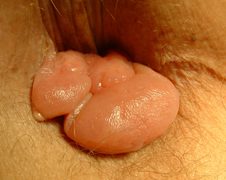Hemorrhoids Online Registration
For the complete information on hemorrhoids, please go to the website hemorrhoidheal.com.
Introducing a fast and effective solution that takes out your fear of hemorrhoid treatment!

More than 10 million people in the United States suffer from hemorrhoids. Three out of four people will develop hemorrhoids at some time in their lives. While many people associate hemorrhoids with painful surgery, only a small percentage of patients actually require surgery. A fast and simple office procedure has taken the fear out of hemorrhoid treatment. The majority of hemorrhoids patients are good candidates for the non-surgical treatment, Infra-red coagulation (IRC).

IRC is a safe, fast and effective solution for hemorrhoids. It is approved by the FDA for the treatment of hemorrhoids. This office-based procedure takes just a few minutes and uses infrared light to comfortably treat symptomatic internal hemorrhoids.
IRC offers major advantages to patients over previous hemorrhoid treatment methods:
- Fast, simple, and safe solution
- No anesthesia required
- No special preparation needed
- No recovery time after treatment
- Clinically proven results
- Covered by Medicare and most major insurance companies
Please click hemorrhoidheal.com for more detail of hemorrhoid and IRC treatment.
Rubber Band Ligation
Rubber band ligation is an office procedure in which the prolapsed hemorrhoid tissue is tied off at its base with rubber bands, cutting off the blood flow to the hemorrhoid. Rubber band ligation works very well for prolapsed hemorrhoids, such as the advanced grade 2 and grade 3 hemorrhoids. It cannot be performed if there is not enough tissue to pull into the banding device. This procedure is almost never appropriate for grade 1 or mild grade 2 hemorrhoids, or most severe (grade 4) hemorrhoids.
The process involves a doctor inserting an anoscope into the anus and indentifying and grasping the prolapsed hemorrhoid with an instrument to place a rubber band around its base. With the rubber band in place, the hemorrhoid shrinks and recedes, dying off in a few days or a week. The reduced volume of venous tissue with the scar formation prevents hemorrhoid tissue bulging into the anal canal. The procedure is done in a doctor’s office and only a couple of minutes. Treatment is limited to 1 to 2 hemorrhoids each office visit and additional areas may be treated at 2 week intervals.
What to Expect After Treatment
After the procedure, you don’t feel much discomfort; some patients may feel tightness and mild pain or feel as if you need to have bowel movement. People respond differently to this procedure. Most patients are able to return to regular activities (but avoid heavy lifting) almost immediately. Others may need a few hours or a day of rest. If you feel some pain after banding, you may use Tylenol or Ibuprofen as needed and do a lot of sitz bath for 15-30 minutes at a time to relieve discomfort. Some patients may have slight rectal bleeding in a week, when the hemorrhoid dies off. The bleeding usually stops by itself; however, if you notice significant rectal bleeding, then you should call your doctor’s office. It is also very important to make sure that your stool is soft by taking stool softeners containing fiber and drink more fluids to help prevent hemorrhoids in the future.
Please click hemorrhoidheal.com for more detail of hemorrhoid and banding treatment.
Hemorrhoidectomy
While most internal hemorrhoids can be successfully treated with non surgical methods such as infrared coagulation and banding, external Hemorrhoidectomies may be performed to remove external hemorrhoids as part of complete hemorrhoid care.

Before Surgery

After Surgery
During this procedure, the prolapsed tissue is surgically removed with a radiofrequency device under local anesthesia.
After the hemorrhoid is removed, the incision is cauterized shut. Good hemostasis is achieved with radiofrequency device, so sutures are not necessary in the most cases. Medicated gauze is then placed over the remaining wound.
Healing time is generally two to four weeks. During this time, you must do a lot of Sitz bath with warm water every day, increase fiber intake, drink plenty of fluids and take stool softeners to keep your stool soft. Some bleeding may occur, so blood in the stool is normal.





